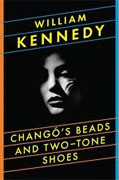Chango's Beads and Two-Tone Shoes
William Kennedy
book reviews:
· general fiction
· chick lit/romance
· sci-fi/fantasy
· graphic novels
· nonfiction
· audio books
· author interviews
· children's books @
curledupkids.com
· DVD reviews @
curledupdvd.com
newsletter
win books
buy online
links
home
for authors
& publishers
for reviewers

 |
Chango's Beads and Two-Tone Shoes William Kennedy Viking Hardcover 336 pages September 2011 |
|
History has shown us that the instruments of revolution can be as varied as the causes they support; the Changó’s beads and two-tone shoes in William Kennedy’s new novel are precisely that—they’re stand-ins for the vehicles of change.
When Daniel lands in Cuba, revolution is simmering against Fulgenico Batista, the Cuban president. There are many young revolutionaries caught up in the business of overthrowing the president and bringing Fidel Castro to power. Among them is the attractive and tempestuous Renata Suarez Otero, a gunrunner whom Quinn promptly falls heads over heels in love with. A practitioner of the Santeria religion with a lot of occult practices mixed in, Renata’s wild and impulsive attitude is a source of endless intrigue for Daniel. In the meantime Fidel has been plotting his revolution in the Sierra Maestra mountains, and Daniel is impatient for a big “get”: he wants to interview the commandante and find out what really makes him tick. Kennedy’s descriptions of Cuba—the floor-to-ceiling mirrors, and the baroque Carrara marble in the mansions along with the contours of the rugged countryside—are evocative and beautifully done. Eventually Renata’s dalliances with the revolutionaries catch up with her, and she and her now-husband, Daniel Quinn, must decide to leave Cuba before things get much worse. They land in Albany, Kennedy’s old stomping grounds, to another revolution, this one much more subtle and incipient. It is 1968, and Robert Kennedy has just been shot. The action the book covers occurs over a single day, one soaked with racial tension, that concludes with the leader’s death. Kennedy does a superb job of showing the political machinations of a corrupt government, one where money is used to buy the poor black vote and the press is used only to further the cause of the politically powerful. Yet there are signs of hope. Young blacks are taking to the streets, demanding change. It was a time that The Brothers, an Albany-based civil rights group, was taking root and organizing to press for justice. Here, too, Daniel Quinn is observer and chronicler, although the narrative weaves around two additional strong men: Tremont, a young black radical, and Matt Daugherty, a priest who is in trouble for having supported the black cause. Renata’s role in this new revolution is less direct but important nevertheless. Daniel’s father, a fading George Quinn, is also a key player in the narrative. His short-term memory might be failing, but his remembrances of Albany in the past bring the city to vibrant life on the page. When he remembers two Walter Dendy Sadler prints on the walls of an elite club, you can totally picture the old times in all their questionable glory. The dialog in Chango's Beads and Two-Tone Shoes Where Kennedy stumbles a little is in trying to explain the connections between the Cuba and Albany narratives. “Albany had entertaining corruption and was wide open like Havana,” he writes. That might indeed be the case, but still the jump is fairly sudden and abrupt. One can’t help but wonder if Kennedy, who also covered the Cuban revolution as a reporter, settled on this device simply as a way of working in his material. Of course, such a device is totally understandable and is laid out extremely well. In an interview for the book, Kennedy explains that he quit journalism because “I couldn’t write only of society’s daily doings. I was much more interested in what people were thinking and why they were doing things.” In other words, the medium did not serve his goal well. In the book, Quinn feels the same way. He wants to write about Tremont but he is silenced. “The medium—that so-called first draft of history proved to be not the message but the anti-message,” he writes. So it is that Quinn (like his creator, Kennedy), sets out to put Tremont’s story down not in a newspaper but in a novel. The idea works. As Chango's Beads and Two-Tone Shoes Originally published on Curled Up With A Good Book at www.curledup.com. © Poornima Apte, 2011 |
|
|
|
 Click here to learn more about this month's sponsor! |
|
| fiction · sf/f · comic books · nonfiction · audio newsletter · free book contest · buy books online review index · links · · authors & publishers reviewers |
|
| site by ELBO Computing Resources, Inc. | |
 The Pulitzer-winning Kennedy, who gave up an illustrious career in journalism to take up fiction, gives us two broad stories of revolution—one set in Cuba in the late ‘50s, and the other in Albany, New York, in the late ‘60s. Tying the two disparate narratives together is Daniel Quinn, a journalist with a keen eye for a story.
The Pulitzer-winning Kennedy, who gave up an illustrious career in journalism to take up fiction, gives us two broad stories of revolution—one set in Cuba in the late ‘50s, and the other in Albany, New York, in the late ‘60s. Tying the two disparate narratives together is Daniel Quinn, a journalist with a keen eye for a story.